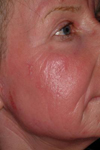Lasers produce an intense beam of bright light of one color (wavelength). Different lasers are selected to treat different parts of the skin (hair, blood vessels) at different depths. New laser systems are extremely accurate and targeted, providing enhanced results and improved safety.
Laser light can gently produce a controlled injury that leads to just enough of trauma to encourage new skin cell growth. In short, old skin cells are removed to make way for new skin cells. This offers an effective and non-surgical way to treat wrinkles, scars and blemishes.
Laser resurfacing can performed in the office to achieve the following:
- Erase fine lines and wrinkles of the face
- Smooth and tighten eyelid skin
- Lessen the appearance of wrinkles around the eyes ("crow's feet")
- Soften “pucker” marks and “frown lines”
- Remove pigmented spots, such as age spots.
- Improve the appearance of scars
- Improve the overall tone and textures of the skin
Before, During & After Laser Resurfacing
The following images show the skin changes immediately before laser resurfacing and immediately after treatment.
 |
 |
 |
 |
Laser resurfacing is often combined with other dermatologic procedures, such as dermal fillers or Botox, to maximize cosmetic results.
Some of the lasers used for laser resurfacing include the carbon dioxide (CO2) laser and the Erbium: YAG Laser.
These lasers are sometimes referred to as “ablative” lasers because they heat up and remove the top layer of skin. This is different from “non-ablative” lasers that target the deeper layers of the skin and leave the top layer intact. Non-ablative lasers stimulate collagen growth and tighten underlying skin to improve skin tone and remove fine lines and signs of skin damage.
Because the top layer of skin remains undamaged by non-ablative lasers, there is rapid healing with almost no "downtime."
Your physician will recommend a laser treatment using ablative and/or non-ablative lasers depending on your skin type (light or dark), the area of the body being treated, and your stated cosmetic needs.
Laser resurfacing is uncomfortable and your physician will discuss with you the options for pain control.
Treated areas usually appear red or pink and may be covered with a fine crust for several days. These areas should be kept moist with ointment or surgical bandages for the first few days following treatment. The treated areas must be protected from sunlight after the procedure. Sunscreen can be used after healing is complete and cosmetics can usually be applied after 10-14 days.
Significant complications are rare, and the risk of scarring is low.
Source: Vivacare
Last updated : 5/13/2022